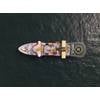Seakeeper Sets Standard for Stabilizing Naval Vessels
Crews aboard naval vessels benefit from having a stable operating platform to help carry out their specialized missions with optimal safety and efficiency. An increasing number of U.S. Navy craft now use Seakeeper actively controlled gyro stabilization systems to mitigate ship roll. Compact, efficient and completely internal, they create significant roll reduction whether a vessel is underway, or at low or zero speed.
Under contract with the U.S. Navy, Modutech Marine, Inc. of Tacoma, Wash., recently completed the first of four 95-foot Range Training Support Craft, each equipped with three Seakeeper M26000 gyro stabilizers. Modutech Marine's full-service boatyard builds a wide range of work, fishing and patrol craft up to 115 feet. Now being fit with government-furnished equipment, the first vessel's final delivery is expected in Guam, according to Modutech CEO Brian Swindahl.
With an average displacement estimated at 130 tons, this state-of-the-art, high-performance vessel will provide critical support to naval operations. A multi-mission weather deck and aft ramp accommodate the launch, recovery and storage of targets such as the MK-30 and BQM-74 aerial targets as well as a variety of torpedoes. Two hydraulic mission equipment handling winches and dual 5.5-ton cranes assist with these tasks. The vessel is also fitted to perform towing operations. "The mission of this craft requires roll stabilization at zero speed. The Seakeeper gyro can deliver this stability where others can't," Swindahl said.
For the vessel's design, Modutech turned to John Myers, principal naval architect with Hockema & Whalen Associates of Seattle. Myers and Modutech had previous experience with Seakeeper gyros on a retrofit for the U.S. Navy 85-foot TWR-8 Deception Pass.
"That was the first I'd heard of Seakeeper, but the Navy had obviously done their homework and knew what they wanted," Myers said. "Seakeeper is a fundamentally different stabilizing technology because it's completely internal and functions whether the vessel is moving or not. There are other stabilization methods out there, but they just don't compete when it comes to the level of roll stabilization in a vessel at rest."
The 95-foot RTSC project differed from the 85-foot TWR-8 retrofit because gyro stabilization was integrated into his design from the start, said Myers. "Once I gave Seakeeper the craft's basic specs, they completed their own study and determined that each vessel would require three of their large units. The stabilization system is essentially built into the hull. I also added covers for the gyros, so potentially unused space above them could provide a storage and work area."
The gyros create the stability necessary for the crew to carry out highly technical work no matter the craft's speed or weather conditions. "Seakeeper's system improves productivity on this vessel simply because it minimizes the amount of time needed for the crew to complete a mission," Myers said. "Instead of having to wait out poor conditions, they can retrieve torpedoes and perform other tasks even in heavy seas."
With their compact size and low power draw, Seakeeper actively controlled gyros are well-suited for both retrofits and new builds. "Whether on military or commercial vessels, crew safety is of paramount importance. Our gyros enhance safety, especially when people are working on deck, while improving overall productivity of both the vessel and those aboard," said Seakeeper COO John Kermet. "Anytime gyro stabilization is involved, it creates more days on the water, which increases ops and use of assets. It also enables the crew to be more fit and, for the military, ready to fight."
Other U.S. Navy workhorse craft relying on Seakeeper stabilization include the 114-foot Range Training Support Craft (RTSC-110) built by Marine Group Boat Works. This full-service boatyard in Chula Vista, California, recently completed a three-vessel contract. The multi-mission boats, each equipped with six Seakeeper gyros, can launch and retrieve small high-speed craft, aerial targets and test weapons. Further distinguished by their environmental soundness, the RTSC-110 runs on 100 percent biofuel.
The U.S. Navy has ordered a fourth vessel from Marine Group, with delivery scheduled for early 2014. Currently under construction at the company's 15-acre waterfront facility, this craft will match its sisters in stabilization technology. Thanks to Seakeeper's continuous innovation, the new vessel needs only three of the company's newer M26000 gyros.














 December 2025
December 2025



